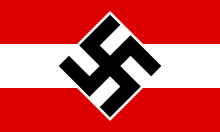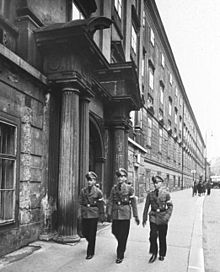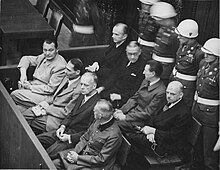Hitler Youth
The Hitler Youth (German: Hitlerjugend [ˈhɪtlɐˌjuːɡn̩t] (About this soundlisten), often abbreviated as HJ, [haːˈjɔt] (About this soundlisten)) was the youth organisation of the Nazi Party in Germany. Its origins date back to 1922 and it received the name Hitler-Jugend, Bund deutscher Arbeiterjugend ("Hitler Youth, League of German Worker Youth") in July 1926. From 1936 until 1945, it was the sole official boys' youth organisation in Germany and it was partially a paramilitary organisation; it was composed of the Hitler Youth proper for male youths aged 14 to 18, and the German Youngsters in the Hitler Youth (Deutsches Jungvolk in der Hitler Jugend or "DJ", also "DJV") for younger boys aged 10 to 14.
With the surrender of Nazi Germany in 1945, the organisation de facto ceased to exist. On 10 October 1945, the Hitler Youth and its subordinate units were outlawed by the Allied Control Council along with other Nazi Party organisations. Under Section 86 of the Criminal Code of the Federal Republic of Germany, the Hitler Youth is an "unconstitutional organisation" and the distribution or public use of its symbols, except for educational or research purposes, is illegal.







Quotes
[edit]- There can be but one German Youth Movement, because there is but one way in which German youth can be educated and trained... This Reich stands, and is building itself up anew, upon its youth. And this Reich will hand over its youth to no one, but will take its education and its formation upon itself.
- Adolf Hitler, Speech on May 1, 1937, quoted in John S. Conway, The Nazi Persecution of the Churches, 1933-45 (New York, NY, Basic Books, 1968), p. 178
- A logical consequence of the Nazi disdain for traditional education was the establishment in 1937 of a new type of school, the Adolf Hitler Schulen (AHS). These schools were placed under the jurisdiction of the Hitler Youth, rather than Rust's education ministry. By the end of 1943 there were 12 of these schools, catering for 2,027 students. Their aim was to provide the future political and administrative elite of the Third Reich, and they reflected the values of the HJ in stressing the importance of physical achievement over academic excellence. Only one-and-a-half hours per day were allocated to lessons, most of which were concerned with ideological topics, in comparison to the five hours each day devoted to sports and physical activities. The major achievement of the AHS was to sink the level of German educational standards to a new nadir. Somewhat more successful were the Nationalpolitische Erziehungsanstalten, or NAPOLAs, which had similar aims to the AHS in seeking to provide the future elite of the Reich. In characteristic fashion, the NAPOLAs, of which there were 21 by 1940, were controlled by the SS in competition with the AHS. NAPOLA students maintained only nominal ties to the Hitler Youth. The aim of the NAPOLAs was to turn out 'political soldiers', whom they produced by immersing their students in a regimen of drill, reinforced by often-brutal physical challenges. The individual identities of the students were suppressed, and group hazing of those who did not fit in was encouraged. That being said, the NAPOLAs did succeed in achieving much higher academic standards than those of the AHS. The approach to education also anticipated the sort of training that recruits in the 'Hitler Jugend' Division were to receive in 1943-1944, with informal relations between teachers and students encouraged.
- Alan Dearn, The Hitler Youth: 1933-45 (2006), p. 28
- Regardless of their motivation, youth who sought to avoid service in the Hitler Youth were treated as dangerous deviants to be crushed ruthlessly. In August 1940 a prison camp for boys aged 13 to 21 was established at Moringen, near Göttingen, which held 1,400 boys by the end of the war. Boys at the camp were used for slave labour under a brutal regime, and could be conscripted into the army for use in dangerous duties such as mine clearance. A similar camp was set up for girls in June 1942 at Uckermark, near Ravensbrück concentration camp. Under the direction of the SS, children could be placed directly into these camps without any legal trial.
- Alan Dearn, The Hitler Youth: 1933-45 (2006), p. 53
- Although many members of the Hitler Youth eagerly looked forward to the chance to fight against the enemy after years of preparation, the actual experience of combat was usually a cruel awakening. The experience and fate of young Germans thrown into battle against the Soviet and Western Allies' armies in the final stages of the war often depended on the choices made by the older NCOs and officers who commanded them. These men often bore the responsibility for whether the children under their command were able to quietly return home or move into captivity when resistance was obviously futile, or whether they were sacrificed to no purpose.
- Alan Dearn, The Hitler Youth: 1933-45 (2006), p. 54
- It is a powerful reflection of the moral bankruptcy of Nazi Germany that there was such a widespread acceptance of the use of child soldiers by 1945. The leadership of the Hitler Youth, Artur Axmann in particular, must bear much of the responsibility for enthusiastically championing a policy that saw tens of thousands of young Germans killed or maimed for no purpose. Against this must be weighed the examples of German army personnel who refused to see them sacrificed in this way, from General Weidling directing the defence of Berlin to many common soldiers who sometimes forcibly restrained members of the Hitler Youth from attacking enemy troops. For those child soldiers who survived, adjusting to the post-war world was often very difficult. Service in the Hitler Youth forced them into a premature adulthood of sacrifice, exhausting work and often danger. The idealism of German youth was turned to bitterness by defeat, and by the knowledge that they had sacrificed their youth to a brutal and corrupt regime. For many of the survivors of Hitler's children still living today, these wounds are yet to heal.
- Alan Dearn, The Hitler Youth: 1933-45 (2006), p. 59
- The songs they sang were Nazi songs. The books they read were Nazi books.
- Richard J. Evans, The Third Reich in Power 1933-1939 (2005), p. 274
- For all their deficiencies, the Hitler Youth movement and the increasingly Nazified school system were driving a wedge between parents who still retained some loyalty to the beliefs and standards they had grown up in themselves, and their children who were being indoctrinated at every stage of their lives. As one such agent ruefully observed: ‘It is extremely difficult for parents who are opponents of the Nazis to exercise an influence on their children. Either they ask the child not to talk at school about what is said at home. Then the children get the feeling, aha, the parents have to hide what they think. The teacher permits himself to say everything out loud. So he’s bound to be right. - Or the parents express their opinion without giving the child a warning. Then it’s not long before they are arrested or at the very least called up before the teacher, who shouts at them and threatens to report them. - ‘Send your father to the school!’ That is the normal answer to suspicious doubts and questions on the part of the child. If the father is quiet after such a visit, then he gives the child the impression that he has been convinced by what the teacher has told him, and the effect is far worse than if nothing had ever been said.’
- Richard J. Evans, The Third Reich in Power 1933-1939 (2005), p. 278-279
- There were even more disturbing reports of children whose membership in the Hitler Youth was disapproved of by their parents threatening to report them to the authorities if they tried to stop them going to meetings. For adolescents, it was only too easy to annoy parents who were former Social Democrats by greeting them at home with ‘Hail, Hitler!’ instead of ‘good morning’. ‘Thus war is taken into every family’, one wife of an old labour movement activist observed. ‘The worst is’, she added apprehensively, ‘that you’ve got to watch yourself in front of your own children.’
- Richard J. Evans, The Third Reich in Power 1933-1939 (2005), p. 279
- The overall effect of Hitler Youth membership, some Social Democratic observers complained, was a ‘coarsening’ of the young. The suppression of any discussion or debate, the military discipline, the emphasis on physical prowess and competition, led boys to become violent and aggressive, especially towards young people who for whatever reason had not joined the Hitler Youth. Hitler Youth groups travelling by train amused themselves by insulting and threatening guards who failed to say ‘Hail, Hitler!’ every time they asked a passenger for his ticket.
- Richard J. Evans, The Third Reich in Power 1933-1939 (2005), p. 280
- The Hitler Youth proved a thoroughly disruptive influence on formal education. ‘School’, one Social Democratic report already noted in 1934, ‘is constantly disrupted by Hitler Youth events.’ Teachers had to allow pupils time off for them almost every week… Despite the military-style discipline in the schools, there were numerous reports of indiscipline and disorder, violent incidents between pupils, and insubordination towards teachers. ‘One can’t speak of the teacher having authority any more,’ noted one Social Democratic agent in 1937. ‘The snotty-nosed little brats of the Hitler Youth decide what goes on at school, they’re in charge.’
- Richard J. Evans, The Third Reich in Power 1933-1939 (2005), p. 289-290
- To reinforce the artillery defence of the approaches to Berlin and of the city itself all available anti-aircraft artillery was mobilized. Over 600 anti-aircraft guns of big and medium calibre were placed in position for anti-tank and anti-personnel defence. In addition, tanks- even those undergoing repairs but with operative artillery equipment- were used as weapons emplacements. They were dug into the ground at road crossings or railroad bridges. Special tank destruction squads were manned out of members of the Nazi youth organization, the "Hitlerjugend." They were armed with Panzer Faustpatronen.
- Georgy Zhukov, The Memoirs of Marshal Zhukov (London: Jonathan Cape Ltd., 1971), p. 597
